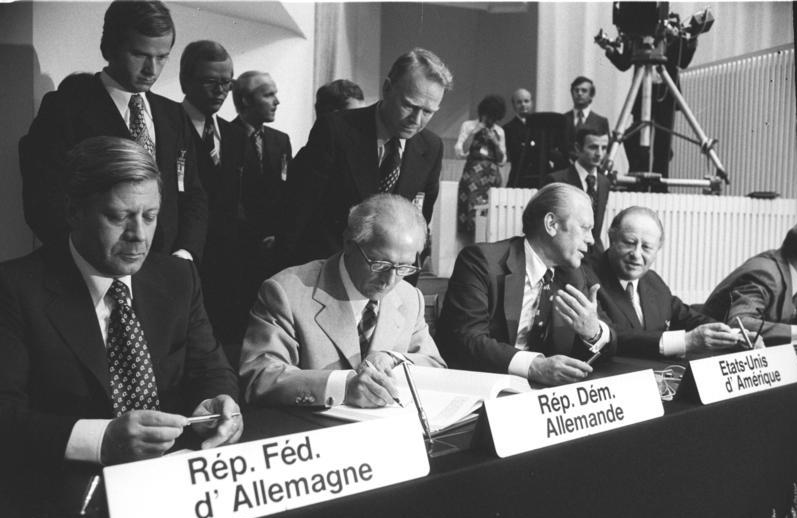|
Transparency In Armaments
Transparency in Armaments (TIA) is an arms control reporting program established by the United Nations General Assembly on December 9, 1991 under UN resolution 46/36L. It calls for annual reporting by UN member states on imports, exports, and holdings of weapons in seven categories: battle tanks; armored combat vehicles; large caliber artillery systems; attack helicopters; combat aircraft; warships; and missiles and missile launchers. Reporting is not required but is strongly encouraged. Reports are sent to the Secretary General of the United Nations and are maintained in the United Nations Conventional Arms Register (UNCAR). Reporting has not been consistent. At least 170 member states and three non-member states have reported at least once since reporting began. However, in 2010, only 72 national reports were received. The highest rate of compliance is by nations that are members of the Organization for Security and Co-operation in Europe (OSCE), because the data required ... [...More Info...] [...Related Items...] OR: [Wikipedia] [Google] [Baidu] |
Arms Control
Arms control is a term for international restrictions upon the development, production, stockpiling, proliferation and usage of small arms, conventional weapons, and weapons of mass destruction. Arms control is typically exercised through the use of diplomacy which seeks to impose such limitations upon consenting participants through international treaties and agreements, although it may also comprise efforts by a nation or group of nations to enforce limitations upon a non-consenting country. Enactment Arms control treaties and agreements are often seen as a way to avoid costly arms races which could prove counter-productive to national aims and future peace. Some are used as ways to stop the spread of certain military technologies (such as nuclear weaponry or missile technology) in return for assurances to potential developers that they will not be victims of those technologies. Additionally, some arms control agreements are entered to limit the damage done by warfare, es ... [...More Info...] [...Related Items...] OR: [Wikipedia] [Google] [Baidu] |
United Nations General Assembly
The United Nations General Assembly (UNGA or GA; french: link=no, Assemblée générale, AG) is one of the six principal organs of the United Nations (UN), serving as the main deliberative, policymaking, and representative organ of the UN. Currently in its 77th session, its powers, composition, functions, and procedures are set out in Chapter IV of the United Nations Charter. The UNGA is responsible for the UN budget, appointing the non-permanent members to the Security Council, appointing the UN secretary-general, receiving reports from other parts of the UN system, and making recommendations through resolutions. It also establishes numerous subsidiary organs to advance or assist in its broad mandate. The UNGA is the only UN organ wherein all member states have equal representation. The General Assembly meets under its president or the UN secretary-general in annual sessions at the General Assembly Building, within the UN headquarters in New York City. The main part of the ... [...More Info...] [...Related Items...] OR: [Wikipedia] [Google] [Baidu] |
Defense Treaty Ready Inspection Readiness Program
The Defense Treaty Ready Inspection Readiness Program (DTIRP) is a United States Department of Defense (DoD) security preparedness and outreach program designed to provide security education and awareness concerning the operational activities associated with arms control implementation. DTIRP uses specially trained personnel, analyses, and educational activities to provide arms control implementation advice and assistance to facilities subject to on-site inspection activities and observation overflights. The authority for the DTIRP outreach program is provided by Department of Defense Instruction 5205.10, Department of Defense Treaty Inspection Readiness Program (DTIRP). This Directive states the purpose of the DTIRP outreach program as being to ensure the continued protection of Department of Defense programs, operations, and activities by providing security preparedness education, assistance, and advice concerning the wide range of operational activities associated with implementi ... [...More Info...] [...Related Items...] OR: [Wikipedia] [Google] [Baidu] |
Secretary General Of The United Nations
The secretary-general of the United Nations (UNSG or SG) is the chief administrative officer of the United Nations and head of the United Nations Secretariat, one of the six principal organs of the United Nations. The role of the secretary-general and of the secretariat is laid out by Chapter XV (Articles 97 to 101) of the United Nations Charter. However, the office's qualifications, selection process and tenure are open to interpretation; they have been established by custom. Selection and term of office The secretary-general is appointed by the General Assembly upon the recommendation of the Security Council. As the recommendation must come from the Security Council, any of the five permanent members of the council can veto a nomination. Most secretaries-general are compromise candidates from middle powers and have little prior fame. Unofficial qualifications for the job have been set by precedent in previous selections. The appointee may not be a citizen of ... [...More Info...] [...Related Items...] OR: [Wikipedia] [Google] [Baidu] |
Organization For Security And Co-operation In Europe
The Organization for Security and Co-operation in Europe (OSCE) is the world's largest regional security-oriented intergovernmental organization with observer status at the United Nations. Its mandate includes issues such as arms control, promotion of human rights, freedom of the press, and free and fair elections. It employs around 3,460 people, mostly in its field operations but also in its secretariat in Vienna, Austria, and its institutions. It has its origins in the mid-1975 Conference on Security and Co-operation in Europe (CSCE) held in Helsinki, Finland. The OSCE is concerned with early warning, conflict prevention, crisis management, and post-conflict rehabilitation. Most of its 57 participating countries are in Europe, but there are a few members present in Asia and North America. The participating states cover much of the land area of the Northern Hemisphere. It was created during the Cold War era as a forum for discussion between the Western Bloc and Eastern Bl ... [...More Info...] [...Related Items...] OR: [Wikipedia] [Google] [Baidu] |


